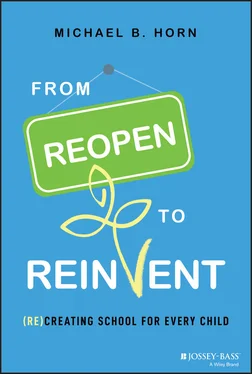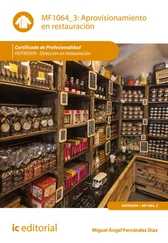Michael B. Horn - From Reopen to Reinvent
Здесь есть возможность читать онлайн «Michael B. Horn - From Reopen to Reinvent» — ознакомительный отрывок электронной книги совершенно бесплатно, а после прочтения отрывка купить полную версию. В некоторых случаях можно слушать аудио, скачать через торрент в формате fb2 и присутствует краткое содержание. Жанр: unrecognised, на английском языке. Описание произведения, (предисловие) а так же отзывы посетителей доступны на портале библиотеки ЛибКат.
- Название:From Reopen to Reinvent
- Автор:
- Жанр:
- Год:неизвестен
- ISBN:нет данных
- Рейтинг книги:4 / 5. Голосов: 1
-
Избранное:Добавить в избранное
- Отзывы:
-
Ваша оценка:
- 80
- 1
- 2
- 3
- 4
- 5
From Reopen to Reinvent: краткое содержание, описание и аннотация
Предлагаем к чтению аннотацию, описание, краткое содержание или предисловие (зависит от того, что написал сам автор книги «From Reopen to Reinvent»). Если вы не нашли необходимую информацию о книге — напишите в комментариях, мы постараемся отыскать её.
From Reopen to Reinvent,
From Reopen to Reinvent
From Reopen to Reinvent
From Reopen to Reinvent — читать онлайн ознакомительный отрывок
Ниже представлен текст книги, разбитый по страницам. Система сохранения места последней прочитанной страницы, позволяет с удобством читать онлайн бесплатно книгу «From Reopen to Reinvent», без необходимости каждый раз заново искать на чём Вы остановились. Поставьте закладку, и сможете в любой момент перейти на страницу, на которой закончили чтение.
Интервал:
Закладка:
Now in the fourth school year impacted by the pandemic, her teachers and team just didn't have the same reserves to deal with the heightened expectations. They were all just exhausted—physically and mentally. They were overworked, and the school still struggled with staffing shortages .
Why couldn't parent emotions be focused on something else other than being angry at teachers, Ball wondered. If she were principal of a high school, maybe she could have at least rallied parent emotions around something else, like the opposing players on other schools' sports teams. She knew that sounded better only in theory compared to her current day-to-day reality .
Introduction
In the wake of the COVID-19 pandemic shattering the routines and lives of students, parents, and educators, schools have been through so much.
In the Boston Globe , Sarah Carr told the story of 10-year-old “Daniel”—his middle name to protect his identity. A struggling reader who is dyslexic, Daniel had finally gotten the support he needed from his school district after six years of effort by his parents.
Yet when schools shut down in March 2020, the support stopped—the tutoring, small-group classes, and specific teaching interventions.
Daniel's heartbreaking story was far from unusual, as COVID-19 interrupted schools' operations across the world.
But schools were struggling before the pandemic as well.
Most of these challenges weren't of any one person's making, nor were they the fault of the people who work in schools today. Many of the challenges were the result of structures and processes that were designed long ago for a different age. These structures have become stuck in our world as “the grammar of schooling” or “just the way school is.”
That students start kindergarten fascinated by schooling and end up bored isn't a coincidence. It's the logical outgrowth of how our schools are built. For decades, it was a successful design.
But in today's knowledge economy that prizes intellectual capital—where we need all individuals to build passions and develop their full human potential—it no longer suffices.
Amid the disaster since the pandemic's assault on society and schools over multiple school years, there is opportunity to rebuild better by altering the fundamental assumptions undergirding our present-day schooling model.
Despite my background, this isn't a book about disruptive innovation.
Nor is it a book about the devastation and disruption that the pandemic caused.
It's about what we build out of this devastation. What we choose to create.
It starts with educators.
Although there are many obstacles over which educators have little control, this is a book for administrators, teachers, and those communities involved in schools—parents and school boards—to help them reconceive what they are trying to accomplish and create a more supportive model that allows them to better serve each child. For parents frustrated with the challenges their children have faced at schools, the book presents a path forward from the pandemic.
It's also a book for policymakers and voters to help them rethink what is standing in the way of building better learning opportunities for all individuals.
The idea of this book is to shift us from seeing the pandemic as a giant threat to also viewing it as an opportunity. An opportunity to overthrow an education system that's not working as well as it could for anyone—certainly not for low-income students. Certainly not for far too many boys and girls who are judged by the color of their skin rather than for their vast potential. Nor is it working for wealthy and privileged children in our society, despite popular perception.
THE SCHOOL SYSTEM ISN'T OPTIMIZED FOR ANYONE
In a podcast called Class Disrupted that I started during the pandemic with Diane Tavenner, the founder of Summit Public Schools, a network of 11 schools in California and Washington State, we told two stories of fictional students to illuminate a flawed education system that treats students not as individuals but as parts of a group.
The first student we called Jeremy, an only child of a single mom who works multiple minimum-wage jobs, which leaves Jeremy home alone at many points during the day. The other student we called Julia, a student from an upper-middle-class home with lots of parental support.
In the podcast, we talked about why and how the school system doesn't work well for students like Jeremy along three dimensions: resources, curriculum, and sorting.
Resources
Today's school system assumes that children like Jeremy will have tools, resources, and opportunities—when in fact they aren't readily accessible to them.
Families with means can buy enrichment and advancement opportunities or, at the minimum, childcare. But families without these resources just have to make do—whether that means hours in front of the TV and video games, or worse. Jeremy has no access to summer camp or other chances to expand his horizons and imagine life outside of his home and immediate neighborhood. In normal years, when Jeremy returns to school in the fall, his classmates have done everything from coding to sports to arts camps. Or they've taken advanced math classes so they can get an edge when they go back to school. Jeremy has none of that.
The system also assumes that Jeremy has access to things like computers and the Internet—or even books at home to build his background knowledge across an array of subjects, which will give him the foundation to learn what his school teaches. But as we've learned during the pandemic, many families can't afford these tools and services. Even after roughly a year of trying to get all children connectivity, somewhere between 9 and 12 million students still didn't have adequate Internet at home. 1
It's not like Jeremy's mom consciously realized she couldn't afford all these products and services. No one sent her a list. Families with means talk and network to find these opportunities. Families without struggle.
Curriculum
In life, success isn't just about the academic knowledge one masters or one's “intelligence.” Those are important, but other skills and habits are also critical. After achieving a baseline of academic preparedness, many studies suggest that these other skills and habits, along with access to social networks, rise in importance.
Jeremy misses building these skills and habits because his school's curriculum doesn't adequately address them.
In many schools, things like working on projects, teaching habits of success, providing actionable feedback, and connecting students to new networks of people aren't integrated into the curriculum—or are offered only as a dessert to the traditional main meal.
By not receiving these opportunities, Jeremy misses out on many experiences that could change his life. Take habits of success, which include mindsets and behaviors like self-direction, agency, growth mindset, and executive functions, 2 to illustrate why.
Jeremy, like most of us, didn't come out of the womb as an organized human being. He hasn't learned explicit habits in the context of his academics to help him excel. Not having support to learn self-direction or executive function skills means that it may be hard for Jeremy to complete and turn in his homework each day. Unlike many of his peers, he doesn't have an adult there to remind him. That lowers his self-efficacy.
It's one thing to preach about growth mindset or grit to children, but it's a different thing to model it. Our education system does the opposite of modeling it, instead affixing labels to students, sorting them into static groups, and signaling that their effort doesn't matter.
Читать дальшеИнтервал:
Закладка:
Похожие книги на «From Reopen to Reinvent»
Представляем Вашему вниманию похожие книги на «From Reopen to Reinvent» списком для выбора. Мы отобрали схожую по названию и смыслу литературу в надежде предоставить читателям больше вариантов отыскать новые, интересные, ещё непрочитанные произведения.
Обсуждение, отзывы о книге «From Reopen to Reinvent» и просто собственные мнения читателей. Оставьте ваши комментарии, напишите, что Вы думаете о произведении, его смысле или главных героях. Укажите что конкретно понравилось, а что нет, и почему Вы так считаете.












